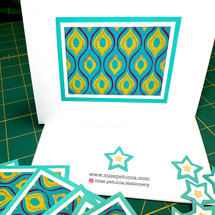Posted by Colleen Taylor on 14th Feb 2025
The Art of Sustainability
In a world increasingly burdened by environmental challenges, sustainability has become more than just a trend—it’s a necessity. From fashion to food, we're all seeking eco-friendly alternatives that reduce waste and promote responsible consumption. The art world is no exception, and one area where sustainability is making a profound impact is in stationery... and we're particularly excited about that!
The Problem with Conventional Paper
It's important to understand the environmental footprint of conventional paper production. The global paper industry is one of the leading causes of deforestation, consuming millions of trees annually. Additionally, paper manufacturing requires significant amounts of water and energy, contributing to pollution and carbon emissions. Despite efforts to increase recycling rates, much of the paper we use still comes from virgin wood pulp, leading to habitat destruction and biodiversity loss.
Stationery lovers like us, often find ourselves at a crossroads—how can we continue to create while minimizing our environmental impact?
Artists, writers, and creatives alike are increasingly turning to handmade recycled papers as a conscious choice, not only for their beauty but also for their environmental benefits. One of our absolute favorite examples of sustainable handmade paper is Shizen paper, produced by skilled artisans in India. Shizen is created using 100% post-consumer waste and the result is a high-quality, acid-free, and TREE-FREE paper that is perfect for all kinds of artistic applications.
What Makes Shizen Handmade Paper So Special?
Shizen, meaning “natural” in Japanese, is a fitting name for this eco-conscious paper, as it embodies the principles of sustainability, artistry, and cultural heritage. Artisans use recycled cotton rags (old t-shirts, etc.), other leftover textiles, and plant fibers to produce sheets that are not only eco-friendly but also uniquely textured and visually stunning. Repurposing the seemingly endless supply of these materials helps reduce landfill waste and eliminates the need for tree harvesting.
Unlike factory-produced paper, which relies on chemically intensive processes, handmade papers are created with minimal environmental impact. The process is low-energy, relying on hand-pulping, natural drying, and minimal use of machinery. The production of these papers is often passed down through multiple generations, literally keeping this centuries-old art form alive.
Shizen paper is also known for its durability, making it an excellent choice for mixed media, watercolor, and even letterpress printing. Its resilience allows artists to experiment with different techniques without worrying about the paper breaking or warping.
For artists and stationery lovers, Shizen paper offers more than just an eco-friendly option—it enhances the creative experience. Whether you’re writing a heartfelt letter, sketching an idea, or crafting a journal, Shizen paper transforms everyday stationery into a mindful, artistic practice.
Here’s How We See It
Choosing handmade recycled paper like Shizen is not just an environmental decision—it’s an act of supporting skilled artisans and sustainable craftsmanship. Many of the artisans who create Shizen paper work in small, family-run workshops, where traditional methods are preserved and even revered. By purchasing and using handmade paper, we’re contributing to fair wages, ethical labor practices, and the continuation of an age-old craft.
The demand for sustainable papers is growing, and with it, innovative solutions are emerging. From tree-free papers made from agricultural waste to biodegradable inks and eco-conscious packaging, the stationery industry is evolving to meet the needs of environmentally aware consumers. Shizen handmade paper represents a small but important step in the right direction—proving that sustainability and beauty can coexist harmoniously.
As artists and creatives, we have the power to shape the future of art and stationery. By choosing materials that honor both craftsmanship and the planet, we become part of a movement that values creativity without compromise.

